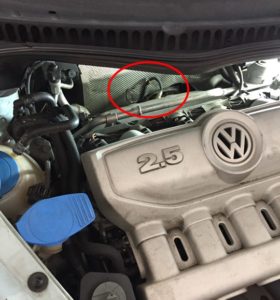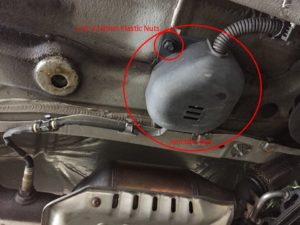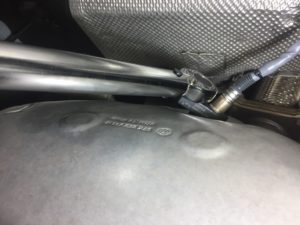 I spent a lot of time the other day looking for a clear web page on replacing the O2 sensor on my daughter’s 2006 VW Beetle and never found good, clear and helpful information. So, I thought that I’d throw-up a page in an effort to help the next guy. Here it goes….
I spent a lot of time the other day looking for a clear web page on replacing the O2 sensor on my daughter’s 2006 VW Beetle and never found good, clear and helpful information. So, I thought that I’d throw-up a page in an effort to help the next guy. Here it goes….
It all started when the check engine warning light came on. I pulled-out my trusty OBD Scan Tool and checked the engine codes to see what the problem was. If you don’t have an ODB (On-board Diagnostics) scanner you can get one for under $100 these days, or if you don’t think that you’ll use it enough to justify buying one, most local auto parts stores will scan your ODB codes for free.
ODB Scanner Tool
In my case I had 4 codes that all pointed to an O2 sensor malfunction:
- P2251 – O2 Sensor Negative Current Control Circuit / Open Bank 1 Sensor 1
- P0130 – O2 Sensor Circuit Bank 1 Sensor 1
- P0131 – O2 Sensor Circuit Low Voltage Bank 1 Sensor 1
- P0135 – O2 Sensor Heater Circuit Bank 1 Sensor 1
Vehicles with V6 / V8 engines have 2 sets of O2 sensors (one on each side of the V), but the Beetle has only 1 Bank (Bank 1). That Bank has 2 sensors (Sensor 1 and Sensor 2). Sensor 1 is located in the exhaust system between the engine and the catalytic converter, and it’s called the “upstream” sensor because it’s upstream from the catalytic converter. Sensor 2 is located between the catalytic converter and the muffler and is called the “downstream” sensor.
The upstream sensor tends to fail more often than the downstream sensor, but either can fail.
On the New Beetle the upstream sensor is located in the exhaust manifold itself and it can be accessed pretty easily from under the hood:
And, the downstream sensor is located in the exhaust pipe under the car:
The wiring connecting both of the O2 Sensors is attached within the same junction box immediately next to the catalytic converter:
The junction box can be removed by removing the 2 10mm plastic nuts that hold it in place.
IMPORTANT: The Beetle is very low to the ground and it will need to be jacked-up in order to access the junction box and/or O2 Sensor 2. Never work under a car unless you are confident that it is secured with jack stands or on ramps to insure the vehicle can not fall.
Once removed you’ll see that the 2 sensors are different. The brown connector is a 4-wire connector for the downstream sensor, and the black connector is a 6-wire connector used for the 5-wire upstream O2 sensor (that’s correct, a 6-wire connector connecting the 5-wire O2 sensor):
IMPORTANT: On the 2006 Beetle
- Sensor 1 (upstream) is a 5-wire wide-band sensor and must be replaced with a similar sensor. The 5-wire sensor costs between $150 and $250 (much more than the generic 4-wire sensors that are available, and its more difficult to find and may need to be ordered).
- Sensor 2 (downstream) is a 4-wire O2 sensor, and two types of sensors are available to replace it. First, “direct replacement” OEM type sensors can be purchased that plug right in where the old sensor was. Second, they sell generic sensors that work fine, but they’re intended to be used on different vehicles and therefore don’t have the plug that fits the vehicle preinstalled on the cable. You must therefore cut the end from the original sensor and splice it onto the sensor cable. Bosch sells such a sensor that comes with a splicing device. A good video that shows the preparation of the cable can be found here: Bosch O2 Sensor Cable Splicing Video
4-wire OEM O2 Sensor (part no. 15733)
These connectors have a small angled Pin and notched and tab that ensures they don’t accidentally detach while driving. You must lift the tab or pry it up with a screwdriver to remove the connector:
Next, a little information about actually unscrewing the O2 Sensor from the exhaust manifold (Sensor 1) or pipe (Sensor 2). The location of Sensor 2 should allow you to use a standard 7/8″ opened end wrench. It may be helpful to run the vehicle for a few minutes to heat up the exhaust pipe, or use penetrating oil to loosen the sensor. However, do not apply penetrating oil to a hot exhaust system as that could cause a fire.
Sensor 1 is a little more difficult. Unfortunately, a heat shield covers the exhaust manifold:
This makes it almost impossible to get a grip on the sensor with a regular wrench. Two types of wrenches are made for removing O2 sensors:
IMPORTANT: The more common type of wrench on the left will not work with the standard / OEM sensor on the Beetle. The sensor is too call to fit in the wrench preventing the wrench from engaging the sensor:
The other (open top) wrench works very well with the Beetle sensor:
And, there’s plenty of room to get the socket on both sensor 1 and 2 on the Beetle:
Finally, if you purchased the OEM replacement O2 sensor it should come with anti-seize compound on the threads to prevent the sensor from fusing in the threads and making the next replacement go much better:
If your sensor doesn’t have anti-seize you should buy some. Just be sure to apply it to the threads and not contaminate the end of the sensor itself. Then torque the sensor to 37 ft. lbs.
Anti-Seize
The good news is that sensor replacement is pretty easy and should take about an hour, and you’ll save about $250 doing it yourself!












